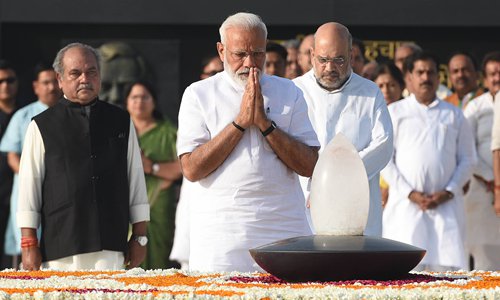HOME >> OPINION
Difficult for Washington to rope in New Delhi into Indo-Pacific Strategy
Source:Global Times Published: 2019/6/4 19:23:41

Photo: VCG
The US Department of Defense released its Indo-Pacific Strategy Report over the weekend. Now that the theoretical framework of the strategy is complete, there remain uncertainties about how the rhetoric will translate into reality.
US, Japan, Australia and India are the pillars of the Indo-Pacific Strategy. But currently, the role of the key player - India - is missing. The Australian Defense Force is relatively small with about 60,000 full-time active-duty personnel. As for Japan, it hosts 23 US military bases. The active and reserve personnel of Japan's Self-Defense Forces stand at 300,000, most of who are deployed in Northeast Asia and can hardly focus on the mission of containing China. Therefore, the US must woo India to join its strategic canvas.
At the Shangri-La Dialogue, US Acting Secretary of Defense Patrick Shanahan boasted of US strength by saying that it has more than 370,000 service members in the Indo-Pacific region and the US Pacific Command has four times more assigned forces than any other geographic combatant command.
However, even with a fairly large deployment, the US has so far failed to form a Cold War-like quasi-alliance in the Indo-Pacific region.
This is where we see room for the improvement of China-India relations. During the Doklam border standoff in 2017, China's leadership exercised restraint and eventually the crisis ended peacefully. Bilateral relations, which had almost gone to the edge of the cliff, are back to normal.
Indian Prime Minister Narendra Modi was absent from this year's Shangri-La Dialogue. His keynote speech at last year's gathering disappointed Americans.
Modi had said that India does not see the Indo-Pacific region as a club of limited members or directed against any country.
On the one hand, as an independent state that sticks to non-alignment, India is poised to show an upright posture. On the other, the Indo-Pacific Command does not suit India's interest.
India has the desire to dominate the Indian Ocean. The biggest obstacle to this ambition is the US, not China. While the US wants to inject its influence into the Indian Ocean and New Delhi aims to play a dominant role in the region, there are bound to be strains.
When former US defense secretary Leon Panetta visited India in 2012, he urged closer military relations with the US, while Indian leaders stayed cool to aligning strategically with Washington. Although the Pentagon chiefs keep changing, the essence of the US' Indo-Pacific strategy has not changed.
While the US wants to use India to keep China in check, it is wary of New Delhi's ambition in the Indian Ocean. The Indo-Pacific Command ranges from the US' West Coast all the way to the west coast of India. India will not give in to the US move of stepping into its sphere of influence.
And this is the core of US' Indo-Pacific strategy. Despite the rhetoric, implementing it is difficult. The US wants to dominate the world by aiming high, nonetheless it lacks the power to do so.
Shanahan said during the Shangri-La Dialogue that no one nation can, or should, dominate the Indo-Pacific, which implicitly pointed to China, but this applies to the US itself.
The article was compiled by Global Times reporter Li Aixin based on an interview with Jin Yinan, professor from the PLA's National Defense University, during the Shangri-La Dialogue in Singapore last week. liaixin@globaltimes.com.cn
Posted in: